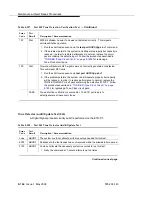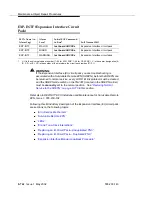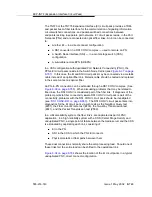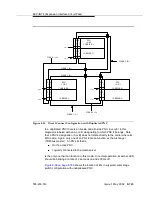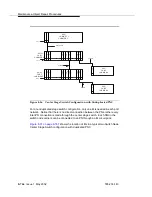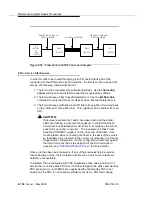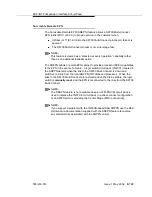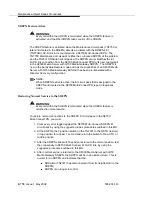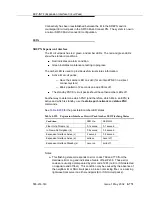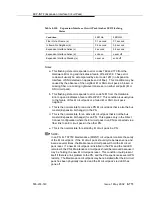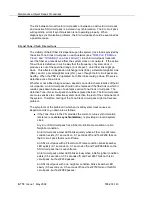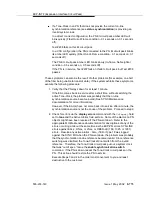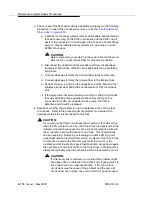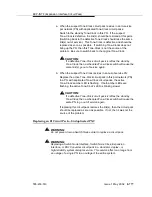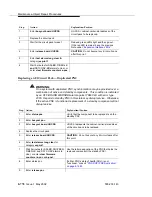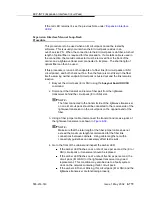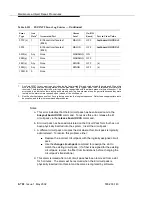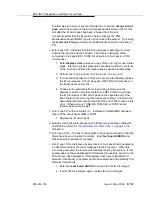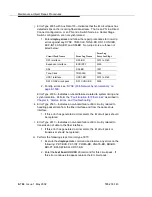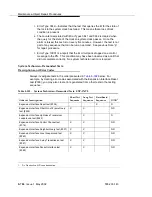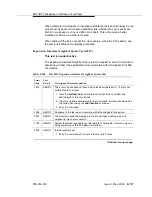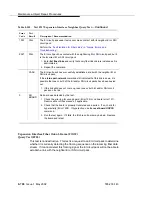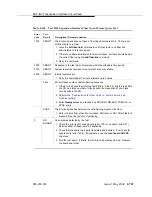
Maintenance-Object Repair Procedures
555-233-143
8-774
Issue 1 May 2002
The link between two active EI circuit packs or between an active EI circuit pack
and an active SNI circuit pack is involved in synchronization. The EI circuit pack
will report slip errors if synchronization is not operating properly. When
diagnosing synchronization problems, the EI circuit packs should be examined as
a possible cause.
EI and Tone-Clock Interactions
The viability of the EI fiber link depends upon the system clock that is provided by
the active Tone-Clock circuit pack on each network (see
and
‘‘TONE-BD (Tone-Clock Circuit)’’
). Each EI circuit pack transmits
over the fiber at a rate derived from the system clock on its network. If the active
Tone-Clock is defective in such a way that the frequency of system clock it
produces is out of the specified range (“out of spec”), an EI fiber link might go
down. This affects an Expansion Archangel Link (EAL), a Remote Neighbor Link
(RNL), and/or a Local Neighbor Link (LNL), even though the EI circuit packs are
healthy. When the PNC is duplicated, both fiber links could go down if there is a
defective active Tone-Clock.
Whether or not a fiber link goes down, depends on certain characteristics of the EI
circuit packs. An EI circuit pack should not be replaced if the fiber link on which it
resides goes down because of a defective active Tone-Clock circuit pack. The
defective Tone-Clock circuit pack should be replaced instead. The EI circuit packs
are more sensitive to a defective system clock than the rest of the components of
the system. Therefore, testing of the Tone-Clock circuit pack might not reveal a
problem.
The symptoms of the problem in which an invalid system clock causes an
Expansion Link to go down are as follows:
■
If the Tone-Clock in the PN provides the current on-line synchronization
reference (see status synchronization), is providing an invalid system
clock:
Any EI or SNI circuit pack has a Fiber Out-of-Frame condition or a No
Neighbor condition.
An EI circuit pack amber LED blinks quickly when a Fiber Out-of-Frame
condition exists (0.1 seconds on, 0.1 seconds off) and Test #238 fails on
the EI circuit pack that is out-of-frame.
An SNI circuit pack with a Fiber Out-of-Frame condition blinks its amber
LED quickly (0.1 seconds on, 0.1 seconds off) and Test #989 fails on the
SNI circuit pack that is out-of-frame.
An EI circuit pack amber LED blinks slowly when a No Neighbor condition
exists (0.5 seconds on, 0.5 seconds off) and Test #237 fails on this EI
circuit pack, but Test #238 passes.
An SNI circuit pack with a no neighbor condition blinks its amber LED
slowly (0.5 seconds on, 0.5 seconds off) and Test #759 fails on this SNI
circuit pack, but Test #989 passes.
Summary of Contents for S8700 Series
Page 50: ...Maintenance Architecture 555 233 143 1 26 Issue 1 May 2002 ...
Page 74: ...Initialization and Recovery 555 233 143 3 12 Issue 1 May 2002 ...
Page 186: ...Alarms Errors and Troubleshooting 555 233 143 4 112 Issue 1 May 2002 ...
Page 232: ...Additional Maintenance Procedures 555 233 143 5 46 Issue 1 May 2002 ...
Page 635: ...status psa Issue 1 May 2002 7 379 555 233 143 status psa See status tti on page 7 406 ...
Page 722: ...Maintenance Commands 555 233 143 7 466 Issue 1 May 2002 ...

